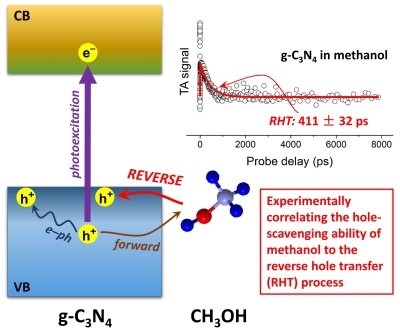New progresses in the study of condensed phase ultrafast spectroscopy and kinetic mechanism
2018-04-16 19:00:15
ã€Chinese instrument network instrument research and development】 Recently, Prof. Luo Yi's team at the Hefei National Institute for Microscale Physical Science at the University of Science and Technology of China has made new progress in the study of ultra-fast spectroscopic and kinetic mechanisms of condensed phase, revealing molecules of methanol. (One of the most commonly used hole sacrificial agents in photocatalytic research) The photoexcitation-backward hole transfer kinetics mechanism that occurs on the surface of a model semiconductor material (g-C3N4). The research results were published in "Experimental Identification of Ultrafast Reverse Hole Transfer at the Interface of Photoexcited Methanol/Graphitic Carbon Nitride System" (Angew. Chem. Int. Ed. DOI: 10.1002/anie.201713102).

Ultrafast Spectral Studies Reveal the Optically Induced Reverse Hole Transfer Kinetics at the CH3OH/g-C3N4 Interface
It is well known that in studies such as photolysis of photocatalytic reduction of water-produced hydrogen and carbon dioxide conversion, in order to increase the utilization efficiency of photo-excited electrons, a hole sacrificial agent is often added to a system to be studied to suppress harmful electron-hole recombination. Although the addition of sacrificial cavities has become a routine operation in the field of photocatalytic research, the mechanism behind the light-excited cavitation dynamics involved in the process is not yet clear, which leads to people often choosing suitable sacrificial cavities. Constrained by experience, there is a certain degree of blindness. For the light-excited cavitation dynamics in the condensed-phase interface system, the current cognition is mainly provided by theoretical description or simulation because it involves the charge carrier behavior of the excited state instead of the ground state. The results are inconsistent or inconsistent with the actual situation. It is difficult to avoid the need for experimental information from the microscopic level.
In light of this, the researchers focused on the photoexcitation cavitation dynamics in the representative CH3OH/g-C3N4 interface system, and used a femtosecond time-resolved ultrafast spectroscopy and kinetic measurement technique to develop a carefully designed comparison and Control experiments. First, by analyzing the ultrafast profile and its evolution under different solvent conditions by comparison, not only the first experimental identification of the inverse hole transfer process (from the sacrificial host molecules to the surface of the semiconductor material) but also the quantification of this The time scale of the process (a few hundred picoseconds). Second, the control experiments of protonated g-C3N4 confirmed that the theoretically predicted deprotonation of methanol molecules adsorbed on the surface of semiconductor materials is the chemical species that dominates the cavity sacrificial ability. In addition, the experimental results are analyzed by contrast at different wavelengths femtosecond laser excitation, it discloses a heat transfer effect of such holes present in the system. More importantly, by analyzing the reverse hole transfer rate in the presence of different cavity sacrificial molecules (such as methanol, ethanol, ethylene glycol, etc.), a microkinetic quantitative criterion for measuring the sacrificial capacity of the cavity was proposed. . The new findings ultrafast spectroscopy and dynamics from experimental studies, will provide guidance and cognitive mechanisms have universal significance of photocatalytic related research.
The first author of this paper is Professor Zhang Zongwei, co-directed by Professor Zhang Qun and Professor Luo Yi. This work was funded by the Ministry of Science and Technology, the National Natural Science Foundation of China and the Chinese Academy of Sciences.
(Original title: New Progress in Convergent Phase Ultrafast Spectroscopic Studies: Optically Induced Reverse Hole Transfer Kinetics)